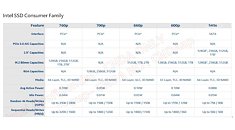Wednesday, August 1st 2018

QLC NAND Flash Based Intel SSD 660p Could Lower Prices of PCIe x4 NVMe SSDs
Intel debuted its 3D QLC NAND flash memory on new SSD DC series 2.5-inch U.2 PCIe drives. Its technology partner Micron, too gave its 3D QLC an enterprise debut with the 5120 ION. The first client-segment debut from the IMFlash combine could be the Intel SSD 660p series of M.2 NVMe SSDs. Slotted between the 700p and the 600p, the new 660p implements homebrew 64-layer QLC NAND flash memory, and a new controller. It comes in sizes of 512 GB, 1 TB, and 2 TB.
The best part about the 660p is its performance numbers. The drive takes advantage of PCI-Express 3.0 x4, and offers (at least on paper), performance numbers identical to those of the pricier 700p. The drives read at speeds of up to 1800 MB/s, with up to 1100 MB/s writes. The 600p, in comparison, capped out at 560 MB/s sequential writes, while the 700p is only slightly higher, at 1200 MB/s. Random access speeds are up to 150,000 IOPS (both reads and writes). QLC pays off rich dividends to consumers by way of price/GB. The 660p 512 GB is expected to be priced at 113.90€ (0.22€/GB), the 1 TB variant at 197.75€ (0.20€/GB), and the 2 TB variant at 391.43€ (0.20€/GB). Not bad for launch prices, considering these are PCIe NVMe drives priced competitively with SATA SSDs.
Source:
WPGHoldings
The best part about the 660p is its performance numbers. The drive takes advantage of PCI-Express 3.0 x4, and offers (at least on paper), performance numbers identical to those of the pricier 700p. The drives read at speeds of up to 1800 MB/s, with up to 1100 MB/s writes. The 600p, in comparison, capped out at 560 MB/s sequential writes, while the 700p is only slightly higher, at 1200 MB/s. Random access speeds are up to 150,000 IOPS (both reads and writes). QLC pays off rich dividends to consumers by way of price/GB. The 660p 512 GB is expected to be priced at 113.90€ (0.22€/GB), the 1 TB variant at 197.75€ (0.20€/GB), and the 2 TB variant at 391.43€ (0.20€/GB). Not bad for launch prices, considering these are PCIe NVMe drives priced competitively with SATA SSDs.

11 Comments on QLC NAND Flash Based Intel SSD 660p Could Lower Prices of PCIe x4 NVMe SSDs
DRAMless and drives like the ADATA SX8200 (using 760p's hardware, ironically enough) leave them no choice but to go under .30$ per GB
Reading has no effect on endurance, so once you fill up that movie or music drive, it should last forever, as long as you don't ever change anything (be sure you get all the tags/cover art perfect before writing). But the price would have to be close to HDDs (2-3¢ /GB) to be feasible, not 20¢/GB as these are. This looks more promising for extremely cheap SATA drives. All this hinges on the actual write endurance of QLC flash cells, of course.
Also, the long term archive persistence (retention) is unknown - will these QLC cells still hold correct digital values after a few months, much less 10 or 20 years down the road? Or will the voltages tend to drift, like the problems already encountered with TLC (reads become progressively slower the longer data is stored). Samsung dealt with this by using an algorithm that periodically re-writes all the files, so that they never have a chance to deteriorate - not ideal, since write endurance is limited on TLC, so this work-around isn't even feasible on QLC.
I suppose we'll have to wait for the accelerated endurance tests that hammer the drive with write/erase cycles. If Intel has conducted these kind of tests, they're not talking.
Also those archiving data would be using various integrity schemes (they're not putting it on just 1 drive) and/or using tape or other avenues for long term storage (10-20+ years). Also consider that 3D Xpoint (Optane) has endurance higher than even SLC NAND. And then there's Samsung's Z-NAND, which treats MLC & TLC NAND like SLC with some special sauce & controller; so higher endurance and inherent qualities.Not for me. I'm going QLC NAND. I don't even care about 3.5" drives.
sammypro
I find it surprising SATA drives, most particularly HDD, have stayed afloat. 512GB should be overkill for most people so long as they're not hoarders.
Are HDDs even viable for enterprise use these days?